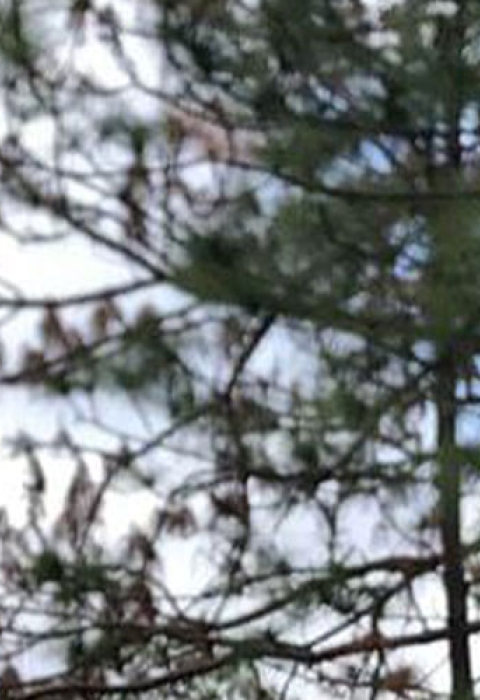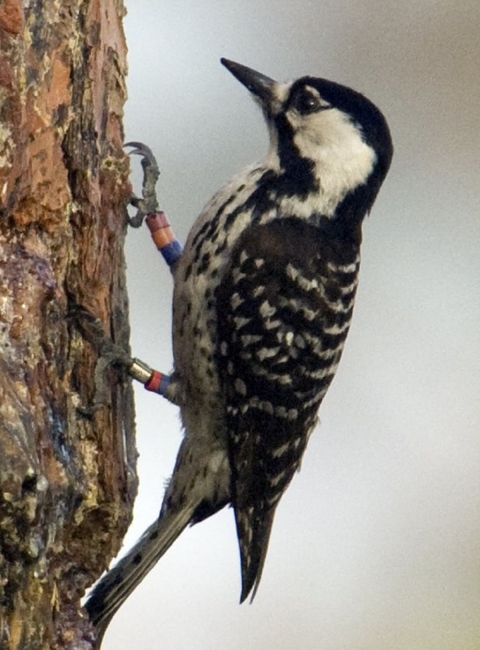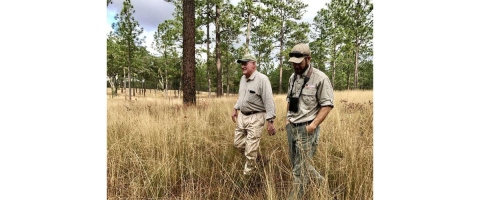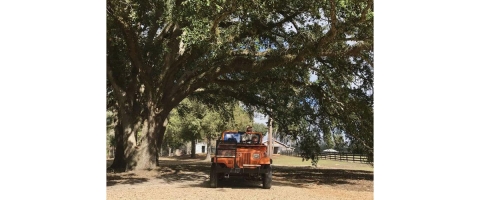Newton, Georgia – They’d probably spent 20 minutes touring the forest when the agent and potential buyer stopped.
The client took it all in – the southwest Georgia sky, a blue that got only deeper as it reached to heaven; and, closer to earth, the longleaf pines, their brilliant green needles prickling that lovely sky. That was enough for Charley Tarver. He turned to the agent.
“Call them,” he said, “and tell ‘em it’s sold.”
And, just like that, an Atlanta businessman took a big step toward becoming a conservationist. That quick decision in 1999 has helped conserve the red-cockaded woodpecker.
The bird, whose status the U.S. Fish and Wildlife Service (Service) currently lists as endangered under the Endangered Species Act and expects to update later this year, is thriving at Longleaf Plantation, 200 miles south of Atlanta. Small surprise: Tarver so loves Picoides borealis that he’s given names to his small, but growing, flock.
He IDs the birds with the help of a scope and leg bands that make each unique.
There’s Eglin, whose name derives from the U.S. Air Force base from which biologists first got him. They placed him in a forested, Southwest Georgia research center. He promptly winged across the road to Tarver’s trees.
In time, the inventory grew: Other (so named because it was known as the “other bird,” showing up after Eglin), Newt, Stella, Nell and Oglia. Oglia? In honor of a friendly waitress at an Apalachicola, Florida, fish camp.
The birds have selected cavities – some man-made, at least one bird-made – in the swaying heights of the longleaf pines that give the name to Tarver’s 1,300-acre tract. The habitat, say biologists, is perfect for the red-cockaded woodpecker, or RCW: big trees growing among fire-maintained wiregrass that carpets the ground, with little underbrush and few smaller trees to impede flight. It’s the sort of place where the bird can nest and do well.
And just the sort of environment that once characterized great expanses of the United States. Three centuries ago, scientists say, longleaf pines encompassed more than 90 million acres, a green swatch that extended from Texas to Virginia. The woodpecker was but one species that found the forests to their liking.
But settlers discovered the tree was good for ship’s masts. The dense wood made great homes. With saw and mule and oxen, men attacked the forests. Their onslaught picked up momentum with the advent of steam and rail lines. The great woodlands dwindled – as did the numbers of the little bird that lived there.
Now, longleaf pines are found on less than 5 million acres of their traditional range – and that’s a slight increase from previous totals; conservationists hope to have 8 million acres of longleaf by 2025. Adding to the birds’ prospects: the maturation of longleaf stands - RCWs nest in older trees - and the smart use of fire to ensure that the underbrush remains in check. As the forests increase, so do the numbers of the black-and-white striped bird that hammers at its bark.
(The cockade? That’s a narrow stripe of red feathers atop the male’s head, on each side of its black cap.)
‘A public-private success story’
Today, the RCW lives in 11 states, from Oklahoma to Virginia. In 1993, the Service estimated nearly 4,700 clusters. Now, about 7,800 clusters inhabit forests.
More RCWs are found on public lands than on private tracts. Eglin AFB, on the Florida Panhandle, has forests where the bird has thrived. Georgia’s Fort Stewart also is home to the bird. Both installations have RCW conservation plans in effect, and have contributed to Tarver’s population by allowing biologists to translocate birds to his woodlands. And, closer to Tarver, is Ichauway Plantation, founded in 1929 by Coca-Cola magnate Robert Woodruff. It’s now known as Joseph Jones Ecological Research Center. It’s where that first bird, Eglin, once lived.
Those facilities boast more RCWs than Tarver’s estate. But that hardly means Longleaf Plantation isn’t important, said Joe Burnam, a biologist with the Georgia Department of Natural Resources (DNR). He credits Tarver, and the DNR’s Safe Harbor Agreement, with creating a healthy environment for the birds.
“It’s something to be proud of,” Burnam said. “It’s a public-private success story.”
It’s a voluntary agreement and incentive, a legal tool under the Endangered Species Act. Restoring and maintaining open longleaf pine requires landowners to actively manage their tracts. That includes prescribed burnings and other treatments. If the treatment has the desired effect – if RCWs increase – the agreement removes any land-use restrictions affecting those additional birds.
Tarver, Burnam noted, is the sort of guy biologists treasure: a private landowner, willing to work with public agencies to preserve endangered species.
“Very few are into [RCWs] like Mr. Tarver,” Burnam said.
It’s part of who he is. Tarver founded an advisory firm that specializes in timberland investment for large institutional clients such as family trusts, university endowments and retirement funds.
His forest roots are bona fide, too. The list of conservation organizations in which he’s active includes the Longleaf Alliance, the Nature Conservancy, the Society of American Foresters and the American Forestry Association.
And he is an unabashed woodpecker fan.
“These birds have been a major deal for me,” Tarver said. “If nothing else, it’s proof that a private landowner can make a difference.”
Chasing a sound
On a recent December morning, wiregrass wet with dew, Tarver headed toward his Jeep to survey the birds’ habitats. Burnam came along. Sam, Tarver’s spaniel, whined; he worried that Tarver was going quail hunting without him. Tarver promised the dog that they’d hunt soon.
The Jeep is Auburn orange and blue – not the preferred colors of Southwest Georgia, where black-and-red UGA flags hang from front doors or adorn pickups. Decades ago, a young Charley Tarver got his forestry degree from the Alabama university. He is a War Damn Eagle.
Tarver eased the machine into the grass, which made a whispering sound along the Jeep’s panels. In the distance, a raptor added another note – scree! Longleaf Plantation is home to a pair of bald eagles.
He stopped the Jeep, got out. A big pine, maybe 150 away, stood apart from the rest. About 25 feet up was a hole – PVC pipe, the entrance to a cavity made of cedar and fronted with metal. Burnam built it. Then he used a chainsaw to cut a hole into the tree, putting putty around it to keep the cavity in place. That was five years ago.
Each remembers the moment. Burnam was on a ladder when he heard the distinct call: sklit! An RCW! He bounded down the ladder and tried to follow the sound. He lost it.
Burnam stuck around until twilight, when RCWs roost. He and Tarver returned to the cavity. Yes! It was the bird Tarver would name Eglin.
Now, Longleaf is home to cavity trees in three clusters. The latest cavity, about 40 feet up a pine that is well over a century old, just seemed to appear. No human had a hand in creating it. Tarver figures that first bird, Eglin, has been working on it for several years to create his own natural roost cavity.
That hole, said Burnam, is an encouraging sign. As the woodpeckers prosper, so do tortoises, snakes, other birds. “There are so many species that are benefitting from RCW management on this property,” he said.
Tarver, who encouraged Burnam to allow RCWs on his property – the word he used is “badgered” – smiled.
“I told him,” he said. “If we built it, they would come.”
They have. Evenings, Tarver likes to visit the cavities. He sets up his scope. He lights his cigar, takes a sip of scotch. He waits. The Georgia sky becomes a deeper blue, and those long pine needles go from green to black.
Then, a flit in the shadows, then a second, a third. RCWs gather. Sometimes they sit on a limb and chatter, as if discussing their day. Other times they arrow into the cavity and call it a night.
And, always, the man who made a quick decision all those years ago gets a long moment of satisfaction.









